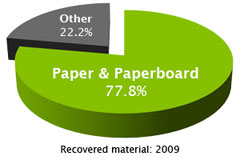Sustainability | Q&A with Kyla Fisher
- Published: October 12, 2012
 Over the past decade, the paperboard industry has seen sustainable practices go from occasional application to the industry standard, achieving new benchmarks in packaging innovation. As companies deliver on the broader promise of sustainability, the industry is manufacturing packages that reduce the product-to-package weight ratio, increase shipping efficiencies, and introduce new more environmentally friendly materials.
Over the past decade, the paperboard industry has seen sustainable practices go from occasional application to the industry standard, achieving new benchmarks in packaging innovation. As companies deliver on the broader promise of sustainability, the industry is manufacturing packages that reduce the product-to-package weight ratio, increase shipping efficiencies, and introduce new more environmentally friendly materials.
True sustainability is a balance between environmental and social stewardship and economic practicality. Cost, performance, and environmental and social impacts all must be managed, beginning with packaging design and specification, moving to manufacturing and distribution, and then the end-of-life of a material.
In this interview with Kyla Fisher, corporate sustainability director at PaperWorks Industries Inc., an integrated packaging supplier headquartered in Philadelphia, PA, Fisher gives us a 360-degree look at sustainable packaging, from current material trends—and managing the overall manufacturing process to achieve sustainability—to the importance of accurately measuring results.
SUSTAINABLE MATERIALS
Q: Are you seeing an increased demand for certain types of sustainable materials?
A. Absolutely. Our customers are asking for higher percentages of post-consumer recycled (PCR) content in paperboard than ever before. Many of the Fortune 1000 have set the goal of increasing PCR content in their materials and are looking for suppliers that can help them achieve a gradual increase over the next decade. In addition, some customers are looking for completely plastic-free and additive-free packaging solutions to address consumer concerns around estrogenic compounds leaching into food and beverage products as well as at end-of-life disposal.
At PaperWorks, we are seeing more requests for biodegradable film in windows on cartons and in blister packs. However, the industry is still exploring the limits of biodegradable materials, looking to see how these materials will be handled in the recycling stream, and if our current collection and waste systems are adequately set up to handle degradable materials.
Brands are also interested in sustainable package coatings and printing. Holobrite, one of our lines, for example, replaces printing directly on foil or holographic board while still providing the reflective nature of these materials. Typically, holographic effects render packaging non-recyclable. This innovative process maintains packaging’s recyclability by micro-embossing a reflective coating onto CRB boxboard. As part of sustainable packaging, this line delivers shelf impact, while eliminating a secondary process, reducing energy needs and waste, as well as cost.
Q: Can you give us an update on the materials regulatory front?
A. Are there any new issues on the horizon? One issue on our radar is in the European Union, where there is growing sensitivity over chemical use in consumer products. Recently, there has been concern regarding the potential risks associated with mineral oil in food packaging. It has been argued that mineral oil saturate hydrocarbons (MOSH), which may be found in recycled packaging, are migrating out of the paperboard into other products. Concern over MOSH is a relatively new development that is still being addressed; however, the science behind the claims is being contested. The EU has deferred regulating MOSH until it has developed a more comprehensive process to assess the true impact of chemicals in food packaging.
It is a situation that we in North America are watching carefully. Recently, the US has started looking at our own chemicals act, and the packaging industry is investigating the use of software tools to help measure the environmental effect of chemicals used in packaging. I’m sure this will drive increased focus on chemicals found in all of our materials and processes over the next decade.
SUSTAINABLE PROCESSES
Q: Beyond using recycled packaging materials, what is your company doing to take the lead on sustainable packaging?
A. When it comes to sustainable packaging, I believe there are two key services our customers are looking for. They are seeking a partner to help them identify sustainability cost savings, and promote sustainable packaging. In addition, they want to know their supply partners internally implement sustainable processes themselves.
My role is two-fold. Internally, I work with our production and plant staff to maximize our resource use. This includes tracking greenhouse gas emissions, exploring ways to reduce energy use, and minimizing waste through recycling programs.
I also work alongside our innovation, design, and sales teams to help customers develop better packaging, going beyond simply promoting sustainable materials. We work directly with the customer at the design stage to see the whole picture and provide the most sustainable options for their packaging. This might mean looking beyond package design to identify more efficient production practices or transportation logistics. By offering comprehensive services that include training, packaging assessments, and design and engineering expertise, we go one step further toward helping our customers understand the complexities involved in creating more sustainable options for their packaging.
Our own sustainability efforts are paying off in various ways. For example, we expect to see some significant cost savings due to the innovative energy efficiency measures and zero waste initiatives that we have implemented at many of our plants. We’ve also received recognition and awards from some of our key customers for our efforts in this area.
SUSTAINABILITY METRICS
Q: What is Life-cycle Analysis and how is it being used?
A: Life-cycle analysis (LCA) is a system that accounts for the material and energy used at every stage of the “life” of a product, including production, processing, packaging, use and retirement, giving us a comprehensive overview of a product’s environmental impact. Too often we quantify sustainability based on limited information, such as greenhouse gas emissions or recyclability. Utilizing an LCA assessment, we include all available information to see the complete picture, helping identify where in a product lifecycle the biggest environmental impacts are and targeting specific areas for improvement.
Unfortunately, LCAs are time-consuming, costly, and often unattainable for small to mid-sized companies. However, there are industry tools that build off these models and help provide similar information.
We make frequent use of the Sustainable Packaging Coalition’s COMPASS software system. When working with a customer on a new design, we can plug in the dimensions and material used to see which design performs better against a series of LCA metrics. This is a great way to see impact of a package across its whole lifecycle. It also drives collaboration with our customer to identify the areas they want to focus on to improve the sustainability performance of a package. This can mean anything from a design or material change, to taking a look at our supply or transportation logistics.
Q: We’re seeing an increased trend towards retailer scorecards. How are these being used and what are the impacts on industry?
A. One of the more visible scorecards is Walmart’s Sustainability Scorecard. It forces Walmart suppliers to measure themselves against several criteria, including recycled content and recovery value. While it’s not an LCA, it makes use of LCA tools to assess the sustainability value of materials used, introducing the concept that sustainability is not just about material choices but also includes transportation, materials sourcing, and the end of life of a product. It also drives the concept of continuous improvement and innovation by scoring products on a bell curve against one another.
The P&G scorecard is another example, asking manufacturers to share how they are using resources internally and what they doing to help drive sustainability with the products they provide to P&G.
When supply chain influencers like Wal-Mart or P&G send the message that they will not do business with suppliers that do not foster sustainable innovation or internally implement sustainable business practices, these scorecards become powerful tools to drive change across the entire consumer products supply chain.
Q: What is your response to this sudden demand for more and better packaging assessments?
A: We have developed our own assessments providing customers with carbon footprint measurements, effective shipping routes, and board savings. In addition, we use standard tools like SPC’s COMPASS for lifecycle analysis and the Walmart Package Scorecard Software.
An exciting industry change in sustainable package assessments is The Global Protocol on Packaging Sustainability (GPPS). Released late 2011, the GPPS is an industry driven initiative focusing on assessments across the lifecycle of product. This initiative helps standardize how the packaging industry defines sustainability by laying out the framework for quantifying sustainability within a package. By pushing package converters to explain the sustainability value in their designs utilizing the same metrics, brand owners can assess packaging on an “apples to apples” basis.
When we customize a sustainability assessment for our customers we take into account the GPPS and report our metrics accordingly. We feel there is great value in making sure our assessments comply with this framework.
Q: There is a growing trend toward co-innovation between brand owners and suppliers to achieve more environmentally friendly packaging. How is this new dynamic changing the way you work with customers?
A: In terms of productivity, the new dynamic is a game-changer. Companies are no longer just order-takers; we’re employing a more collaborative problem-solving approach. This means that we can work more closely with our customers to understand their needs and make actionable recommendations for continuous improvement.
Utilizing the expertise and know-how our people have in materials science, engineering and design, we are able to work with our customers throughout the product lifecycle to develop innovations in sustainable packaging that work.
For example, our team will look at customer packaging lines and processes, working to reduce the amount of waste and realize cost savings. We also apply our engineering and design expertise to develop sustainable packaging solutions that are both effective and efficient. From design to final manufacturing, we apply sustainability throughout the production process, creating packaging solutions that result in higher scorecard ratings.
ABOUT KYLA FISHER
 Kyla Fisher has been the Sustainability Director for PaperWorks Industries for the past two years. During her tenure with the company she has helped the firm obtain over $400 million in grants for energy efficiency improvements to manufacturing sites, increased offerings of sustainability design and technology services, and led numerous workshops and educational workshops on sustainability packaging issues for staff and customers alike. Kyla currently sits as a co-chair of the AMERIPEN working group on Extended Producer Responsibility (EPR), which is seeking to help the industry understand and articulate a position and proposal to anticipated legislation in the United States. Additionally, she is currently engaged as a thought leader on the Paperboard Packaging Council’s Sustainability Task Force, and serves on numerous committees with the Sustainable Packaging Coalition. Kyla has authored one international and two national journal articles on innovative models for sustainable engagement. She has a Masters’ of Arts degree with a focus on sustainability.
Kyla Fisher has been the Sustainability Director for PaperWorks Industries for the past two years. During her tenure with the company she has helped the firm obtain over $400 million in grants for energy efficiency improvements to manufacturing sites, increased offerings of sustainability design and technology services, and led numerous workshops and educational workshops on sustainability packaging issues for staff and customers alike. Kyla currently sits as a co-chair of the AMERIPEN working group on Extended Producer Responsibility (EPR), which is seeking to help the industry understand and articulate a position and proposal to anticipated legislation in the United States. Additionally, she is currently engaged as a thought leader on the Paperboard Packaging Council’s Sustainability Task Force, and serves on numerous committees with the Sustainable Packaging Coalition. Kyla has authored one international and two national journal articles on innovative models for sustainable engagement. She has a Masters’ of Arts degree with a focus on sustainability.
This email address is being protected from spambots. You need JavaScript enabled to view it.




